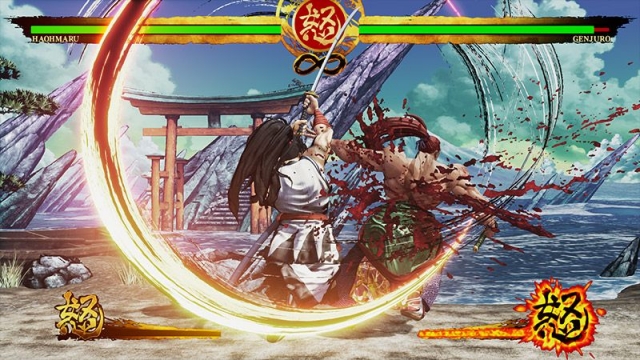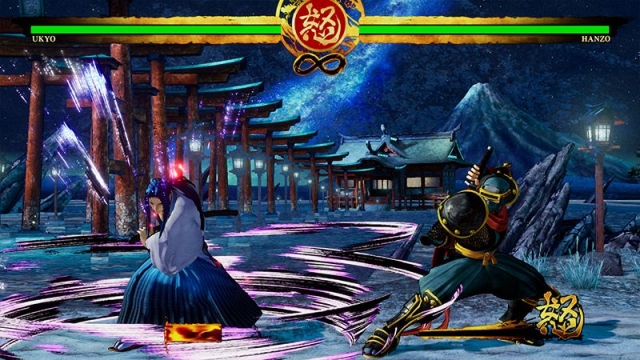Samurai Shodown

It’s hard to believe that the mainline Samurai Shodown series has been dormant for nine years now – but it has. The series went out with Samurai Shodown Sen, which was a needlessly violent and worse, cheap-looking and feeling game in every way. It hurt the series and it didn’t feel like we would ever see a new game. Fortunately, the rise of retro means that the Neo-Geo classics have seen re-releases on pretty much all modern devices and that has greatly expanded the exposure for the series. Now, after nearly a decade passing without a new entry, we get a new game that aims to take what worked before and bring it into a more modern art style with Unreal Engine 4.
Plot-wise, it’s essentially a reboot of the series with a new lore. You still have dark forces afoot and a cast that is largely composed of the roster of the first game with a smattering from later games along with three new characters. The returning roster plays a lot like they did before at their core, so the game feels very familiar the second you start it up as a series veteran. Those playing as Earthquake aren’t going to have the fastest of movement speed, but can deal out incredible damage in a single blow. With under 20 characters, the roster is a tad lean, but there’s definitely a quality over quantity aspect to things.
While fighting games can easily fall into a trap of having a ton of characters that may look great on a box or a press release, the reality is that in many games, the roster feels lifeless and you don’t have much of a reason to play as the entire roster. Samurai Shodown’s roster has always been a strength – not due to sheer numbers, but due to how much each character stands out. The franchise’s best-known character is Haohmaru and his large sword and larger hair remain intact here, while the iconic kabuki warrior Kyoshi keeps the core of what worked before with his painted face, but gains a darker tone with a sinister scowl now. Character posing is also something that remains different here compared to other games, so fighting as Kiyoshi means you will do so with his one-legged hopping style. This requires you to relearn your timing for things like jumps and account for more of his body being exposed because of his front-loaded pose.
Ukyo is another long-time favorite and he’s pretty unique in the sense that his character is always ill, so he coughs after battle. It’s a small thing, but it gives you a glimpse into his character off of just his body language. Tam Tam’s prior super-exaggerated physique has been blown up to ridiculous proportions, but it makes him a far more memorable character to play now as his moveset is more outlandish. In terms of overall feel, this reboot does a perfect job of replicating what a side-view SamSho game should feel like. The quick pace of the later games is kept alongside the feel that every blow matters, which helped make the first game stand out. Much like now, having a game where a single mistake can lead to you taking far more damage from a single blow is quite unusual – but makes you far more attentive than you normally would be.
The face buttons let you choose from light, medium, and heavy attacks, and landing enough will fill up your rage meter. Filling that puppy up entirely lets you unleash a slick attack known as the lightning blade attack that turns your foe all bloody and makes the screen go into a Sin City-esque black and white with only red bloodspray to add some color to the world. It’s an incredible effect and one that feels rewarding to pull off – and devastating to endure. Luckily, if it’s done early enough, you can still recover. That kind of balance is one thing that makes SamSho so fun to play. Every battle has the potential to either see you dominate, or get cocky after a hot streak and then eat defeat in a handful of attacks. Timing is key for using the lightning blade as once it’s used, your rage gauge is done for the fight.
Samurai Shodown is a very challenging game, but also a fair one. While you can be silenced quickly, you can dole out the same level of devastation. The big key is to play carefully and not rush in. This isn’t a game that you can button mash in and do well at. Even at the lowest difficulty level, the AI will find holes in your game and tear you up when needed. While the everyday cast fights fire with fire, the end boss is a traditional SNK Hard-level creation that will have you paying closer attention than ever before to not only your own attacks, but most importantly, hers as you need to note patterns and exact parts of the screen to avoid damage.
Visually, Samurai Shodown is back to looking like a major release again – which is a godsend after the budget-looking SamSho Sen. Character models reflect size better now than ever before, with the towering Earthquake instilling more fear than ever before, while the relatively diminutive Charlotte is dwarfed by many. Animations are more robust now than ever before while retaining the easily-timed nature of the original series – providing the best of both worlds for those who want realistic-flowing attacks that also don’t take forever to see play out on-screen. The environments are some of the best in series history as well – and for a series known for having stunning stages, that’s no small feat. Things like waves ripple in the background and make the world you’re in come alive in ways that aren’t often seen now.
Musically, Samurai Shodown features a lot of high-quality music that may not be something you’ll play at a party, but choose to enjoy later after the fact. The traditional Japanese tracks use a lot of flutes and woodland instruments to create an ominous vibe for tougher fights, and a tranquil feel during more subdued affairs. The Japanese voice work with English subtitles won’t be for everyone, but given the game’s setting and how iffy English voice acting can still be in gaming, it’s probably for the best. Like Yakuza, sticking with the native tongue of the game’s setting helps the atmosphere and prevents it from being shaken by the risk of bad dubbing.
Overall, Samurai Shodown has some rough edges to it – but fewer than any entry has had in around 20 years. It’s the best-playing entry in the series since the legendary second installment, and stands out nicely even in today’s crowded field of fighters. Much like it did in the early ’90s, by being different than the pack with its feudal Japanese setting and story, it allows the core game to be different even if the framework is still a single-plane fighter. It’s a must-play for any lapsed fans of the series and will not only rekindle old memories, but forge new ones for all who play it.
Reviewed By: Jeremy Peeples
Publisher: SNK
Rating: 86%
——————————————————————————–
This review is based on a digital copy of Samurai Shodown for the PlayStation 4 provided by SNK.
 Game Over Online
Game Over Online









